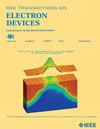An InGaZnO Synaptic Transistor Using Titanium-Oxide Traps at Back Channel for Neuromorphic Computing
IF 2.9
2区 工程技术
Q2 ENGINEERING, ELECTRICAL & ELECTRONIC
引用次数: 0
Abstract
Synaptic transistors have attracted growing interest due to their potential in bio-inspired computing. Conventional synaptic transistors typically rely on charge traps, dipoles, or mobile ions/vacancies in the gate dielectric for channel conductance modulation, which causes performance deterioration owing to Coulomb scattering. Herein, a new dual-gate InGaZnO (IGZO) synaptic transistor is proposed. An unisolated top gate with post metal annealing (PMA) treatment is designed to block moisture and form titanium-oxide (TiOx)-associated defects at the IGZO back channel. By using the TiOx defects rather than the gate dielectric to regulate the channel conductance, Coulomb scattering is avoided, and so the device shows relatively high carrier mobility [~11.5 cm2/(V一种使用氧化钛阱的InGaZnO突触晶体管用于神经形态计算
突触晶体管由于其在生物启发计算方面的潜力而吸引了越来越多的兴趣。传统的突触晶体管通常依靠电荷阱、偶极子或栅极介质中的移动离子/空位进行通道电导调制,由于库仑散射导致性能下降。本文提出了一种新的双栅InGaZnO (IGZO)突触晶体管。设计了一种经过金属后退火(PMA)处理的非隔离顶栅,以阻挡水分并在IGZO后通道形成氧化钛(TiOx)相关缺陷。通过使用TiOx缺陷而不是栅极介质来调节通道电导,避免了库仑散射,因此该器件具有较高的载流子迁移率[~11.5 cm2/(V $\cdot $ s)]和较小的亚阈值摆幅(~231 mV/dec)。此外,成功地模拟了典型的生物突触功能,并且获得了相对较低的器件间电导调制变化(~7.2%)。此外,基于该装置的卷积神经网络(CNN)在图像分类任务中实现了较高的准确率,显示了该装置在神经形态计算中的巨大潜力。
本文章由计算机程序翻译,如有差异,请以英文原文为准。
求助全文
约1分钟内获得全文
求助全文
来源期刊

IEEE Transactions on Electron Devices
工程技术-工程:电子与电气
CiteScore
5.80
自引率
16.10%
发文量
937
审稿时长
3.8 months
期刊介绍:
IEEE Transactions on Electron Devices publishes original and significant contributions relating to the theory, modeling, design, performance and reliability of electron and ion integrated circuit devices and interconnects, involving insulators, metals, organic materials, micro-plasmas, semiconductors, quantum-effect structures, vacuum devices, and emerging materials with applications in bioelectronics, biomedical electronics, computation, communications, displays, microelectromechanics, imaging, micro-actuators, nanoelectronics, optoelectronics, photovoltaics, power ICs and micro-sensors. Tutorial and review papers on these subjects are also published and occasional special issues appear to present a collection of papers which treat particular areas in more depth and breadth.
 求助内容:
求助内容: 应助结果提醒方式:
应助结果提醒方式:


